| This article needs additional citations for verification. Please help improve this article by adding citations to reliable sources. Unsourced material may be challenged and removed. Find sources: "Clark International Airport" – news · newspapers · books · scholar · JSTOR (July 2018) (Learn how and when to remove this message) |
| Clark International Airport Pangyatung Sulapawan ning Clark Paliparang Pandaigdig ng Clark | |||||||||||
|---|---|---|---|---|---|---|---|---|---|---|---|
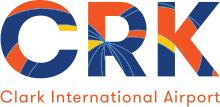 | |||||||||||
 The airport terminal at night in December 2023 The airport terminal at night in December 2023 | |||||||||||
| Summary | |||||||||||
| Airport type | Public / military | ||||||||||
| Owner | Clark International Airport Corporation | ||||||||||
| Operator | Luzon International Premier Airport Development (LIPAD) Corporation | ||||||||||
| Serves | Metro Clark | ||||||||||
| Location | Clark, Angeles City and Mabalacat, Pampanga, Philippines | ||||||||||
| Opened | June 16, 1996; 28 years ago (1996-06-16) | ||||||||||
| Hub for | |||||||||||
| Operating base for | |||||||||||
| Time zone | PHT (UTC+08:00) | ||||||||||
| Elevation AMSL | 148 m / 484 ft | ||||||||||
| Coordinates | 15°11′09″N 120°33′35″E / 15.18583°N 120.55972°E / 15.18583; 120.55972 | ||||||||||
| Website | clarkinternationalairport | ||||||||||
| Maps | |||||||||||
 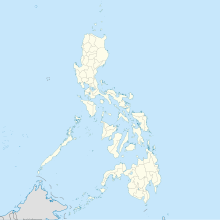 | |||||||||||
| Runways | |||||||||||
| |||||||||||
| Statistics (2023) | |||||||||||
| |||||||||||
| Source: CIAC | |||||||||||
Clark International Airport (IATA: CRK, ICAO: RPLC)—known as Diosdado Macapagal International Airport from 2003 to 2014—is an international airport covering portions of the cities of Angeles and Mabalacat within the Clark Freeport and Special Economic Zone in the province of Pampanga, Philippines. It is located 80 kilometers (50 mi) northwest of Manila. It is accessible by way of the Subic–Clark–Tarlac Expressway (SCTEX).
The airport serves Metro Clark, as well as the entire Central Luzon, Northern Luzon, and, to an extent, Manila metropolitan area and capital city with international and domestic flights. The name is derived from the former American Clark Air Base, which was the largest overseas base of the United States Air Force until it was closed and handed over to the Government of the Philippines in 1991.
The airport is managed and operated by Luzon International Premier Airport Development (LIPAD) Corp., a consortium of JG Summit Holdings, Filinvest Development Corporation, Philippine Airport Ground Support Solutions (PAGSS) Inc., and Changi Airports Philippines Pte. Ltd. The southern part of the facility is utilized by the Philippine Air Force as Clark Air Base.
The airport was nominated as a finalist for the Airport category of the 2021 Prix Versailles [it] awards but lost to LaGuardia Airport Terminal B as the best new airport in 2021. However, it was recognized as a laureate of Prix Versailles' 2023 list of the World's Most Beautiful Airports.
On March 1, 2024, CRK won the Routes Asia Marketing Award under the 5 million Passenger airport category after having handled nearly 2 million passengers in 2023, or a 160% increase.
History
For information on the history of Clark Airport prior to the explosion of Mount Pinatubo in 1991 and the departure of U.S. forces from the Philippines, see Clark Air Base.
The United States Cavalry established Fort Stotsenberg in 1902 and later converted a portion of it into an airfield, which was, in turn, renamed Clark Air Field in 1919—in honor of aviator Major Harold Melville Clark. Clark Air Field was used as a strategic overseas base by both the United States and Japan during World War II.
In 1947, the RP-US Military Bases Agreement was signed, integrating Clark Air Field and Fort Stotsenberg into Clark Air Base but, after the eruption of Mount Pinatubo in June 1991 and the non-renewal of the military bases agreement, Clark Air Base was reverted to the Philippine government.
The Bases Conversion Development Act of 1992 accelerated the conversion of Clark Air Base into a Special Economic Zone, and, in 2007, the Congress of the Philippines enacted Republic Act No. 9400, which renamed the base to Clark Freeport Philippines. It is now segregated in two separate entities: Clark Freeport Zone, administered by the Clark Development Corporation, and the Clark Civil Aviation Complex, administered by the Clark International Airport Corporation (CIAC).
In 1993, the former Clark Air Base was reopened as the Clark Special Economic Zone (CSEZ) after the area was cleared of lahar debris from the Mount Pinatubo eruption and a typhoon that followed. On April 28, 1994, an executive order was signed by former President Fidel Ramos that designated Clark as the Clark Special Economic Zone as the future site of a premier international airport, aiming to attract economic and tourism activities to Central Luzon and relieve congestion in Metro Manila.
In 1997, the development of Clark International Airport (CIA) began in earnest with the signing of a contract involving a developer linked to the proposed new passenger terminal at Ninoy Aquino International Airport (NAIA) in Pasay City. This move was part of the Philippine government's broader strategy to enhance the country's airport infrastructure and alleviate congestion at NAIA. By collaborating with experienced international airport operators and developers, such as Aeroports de Paris (now Groupe ADP), the BCDA aimed to turn Clark into a major international gateway. This development was intended to support regional economic growth and provide a viable alternative to NAIA for international and domestic flights. In that same year, the master plan was drafted. The plan would set up a state-of-the-art aviation complex with a capacity of 10 million passengers a day, while the proposal was to have equipment installed, but building the passenger terminal and the control tower has not yet been completed.
CIAC traces its origin from Republic Act No. 7227, otherwise known as the "Bases Conversion and Development Act of 1992", which authorized the conversion of several military reservations, including the former Clark Air Base, into sustainable economic zones. Jurisdiction over the corporation shifted from the Bases Conversion Development Authority (BCDA) and the Clark Development Corporation (CDC) since its formal incorporation with the SEC in 1995.
The airport opened for commercial operations on June 16, 1996.
On April 4, 2003, President Gloria Macapagal Arroyo renamed the airport to Diosdado Macapagal International Airport (DMIA), in memory of her father, former President Diosdado Macapagal, and ordered the Clark International Airport Corporation (CIAC) in February 2007 to fund the US$1.7 billion (₱76.5 billion) expansion of DMIA and the approval of a US$2 million (₱90 million) study plan financed by the Korean International Cooperation Agency. The first stage of Clark Airport's expansion program, a ₱130 million terminal expansion, was completed in January 2008 to accommodate more than 2 million passengers annually.
The viability and practicability of CIA have been confirmed by studies by Pacific Consultants International in 2005, the Korea International Cooperation Agency in 2008, and Aecom in 2010.
In 2011, CIAC was transferred from the Bases Conversion and Development Authority and became an attached agency of the Department of Transportation and Communications (DOTC) by virtue of Executive Order No. 64 issued by President Benigno Aquino III.
The airport again used the Clark International Airport name in February 2012, but the original passenger terminal continued to bear Macapagal's name until 2014.
On February 28, 2017, President Rodrigo Duterte issued Executive Order No. 14, reverting CIAC as a subsidiary of the BCDA, but with the Department of Transportation (DOTr) maintaining supervision and operational control of the airport.
Expansion and future development
Four new terminals are expected to be completed and all will be fully operational by 2025. Upon completion, these four terminals will boost Clark's passenger capacity to more than 110 million annually. The airport is also being groomed to become one of the country's first "aerotropolis," which is a community that features a world-class airport and surrounded by business clusters and residential developments. The project involves the operations and maintenance of the existing and the proposed new passenger terminal buildings on the airport with a 25-year concession period. The ₱12.55-billion project involves the construction of a new passenger terminal building with a design capacity of twelve million passengers per annum. The proposal was undertaken by the ADP Ingénierie in 2015.
North Luzon Airport Consortium (NLAC), which is a consortium of JG Summit Holdings, Filinvest Development Corporation, Philippine Airport Ground Support Solutions Inc. and Changi Airports Philippines Pte. Ltd. (which is a subsidiary of Changi Airports International Pte. Ltd, which is itself a subsidiary of Changi Airport Group, the operator of Singapore Changi Airport) won the open bid by the BCDA to take over the operations and maintenance of the airport. On January 25, 2019, NLAC signed the 25-year contract for the operations and maintenance for the airport. On August 16, Clark International Airport's operations and maintenance were officially handed over to the winning bid (now renamed as Luzon International Premier Airport Development (LIPAD) Corporation in a ceremony held at the new terminal building along with the unveiling of its new logo.
The new passenger terminal building was completed in September 2020. Trial flights to and from the new terminal were conducted in December 2021, and the terminal opened for commercial operations on May 2, 2022. All flights moved to the new terminal on the day of its opening. Following the opening of the new terminal, the old terminal was decommissioned. The new terminal was officially opened by President Bongbong Marcos during a grand opening event on September 28.
Geographical location
Clark International Airport is located within the Clark Freeport Zone in the island of Luzon, approximately 98 kilometers (61 mi) from Manila in the south and 163 kilometers (101 mi) from Baguio. The airport lies in between Mount Pinatubo to the west and Mount Arayat to the east.
The airport site is inside the Clark Freeport Zone's Civil Aviation Complex which occupies 2,367 hectares (5,850 acres) and directly linked to the Subic–Clark–Tarlac Expressway (SCTEX) which is connected to the North Luzon Expressway (NLEX) providing a direct link to Metro Manila.
It has a local catchment area with an estimated population of 23 million covering the Ilocos Region, Cagayan Valley, Central Luzon, the Cordillera Administrative Region, and northern Metro Manila.
Structure
Passenger terminal
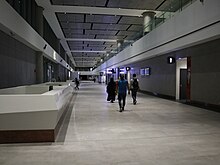
The airport has a 82,600-square-meter (889,000 sq ft) four-level passenger terminal building which replaced the original terminal in 2022. Designed by Populous and Casas+Architects and constructed by Megawide Construction Corporation and GMR Infrastructure, the terminal has a total floor area of 110,000 square meters (1,200,000 sq ft) and a design capacity of twelve million passengers per annum.
The ground level holds the baggage claim and arrival halls, while the second floor holds the transfer facilities, immigration facilities for arriving international passengers, and 18 jet bridges. Aside from the jet bridges, there are remote gates at the apron. The third level houses the check-in counters and pre-departure areas including gate lounges, while the fourth level houses food and beverage areas and commercially important person lounges.
The facade of the terminal sports a wave roof design inspired by the mountains of Mount Arayat, Mount Pinatubo, and the Sierra Madre mountain range.
Former terminal
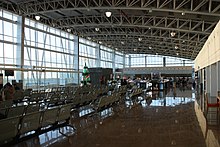
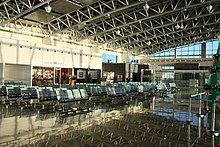 Views of the departure hall of the former passenger terminal in 2013
Views of the departure hall of the former passenger terminal in 2013
The original terminal was expanded for $3 million (PH₱130 million) to accommodate 1 million passengers annually. The expansion project was inaugurated by President Arroyo in April 2008 to serve the growing passenger volume due to the entry of foreign and local budget carriers at the airport.
The first phase of the expansion of the terminal started in April 2010 at a cost of $12 million (PH₱550 million), saw a second story, arrival and departure lounges, and two aerobridges added to the terminal building. The expansion boosted the airport's capacity to 2.5 million annually.
The passenger terminal was expanded again in 2013 at a cost of $9.6 million (PH₱417 million), increasing the capacity of the terminal from 2.5 million to 4.2 million passengers per annum. The expansion increased the size of the passenger terminal building from 11,439 square meters (123,130 sq ft) to 19,799 square meters (213,110 sq ft). It added 21 new check-in counters, increasing the total number of counters from 13 to 34. Five arrival counters and 12 departures counters were also constructed. The expanded terminal has eight entry points and three customs stations. The modernized terminal started operations in May 2013.
Runways
Clark International Airport used to have two 3,200-meter (10,500 ft) parallel runways. Since the runways are closely spaced, the secondary runway (02L/20R) has been decommissioned and is no longer in use. The new terminal occupies the end that was formerly Runway 20R, while a new maintenance hangar is currently being constructed on the stopway of Runway 02L.
- The primary runway (Runway 02R/20L) has a length of 3,200 meters (10,500 ft) and a width of 60 meters (200 ft). It is equipped with various navigational aids and lighting facilities, and it has a Category 1 rating for precision approach.
- The former secondary runway (Runway 02L/20R) has the same length as the primary runway but is only 45 meters (148 ft) wide, 15 meters (49 ft) narrower than the primary runway. Unlike the primary runway, the secondary runway was used for visual flight rules (VFR) only. The secondary runway was decommissioned in 2017.
Air traffic control tower
In 2020, the Clark International Airport Corporation (CIAC) announced plans to construct the tallest air traffic control tower in the Philippines which will stand around 54 meters (177 ft) in height. The tower was projected to be complete by December 2021. However, the project is only 61 percent complete as of December 2023 due to design issues and pending approval from the Civil Aviation Authority of the Philippines and the Clark Development Corporation.
Second hangar
On March 12, 2024, Elmar Lutter, Lufthansa Technik Philippines President announced the groundbreaking project of the P8.4-billion ($150 million) hangar facility at Clark International Airport. Its planned second hangar was unveiled during the Philippine officials' Berlin, Germany visit, led by President Bongbong Marcos and Alfredo E. Pascual.
Airlines and destinations
Passenger
Cargo
| Airlines | Destinations |
|---|---|
| FedEx Express | Bangkok–Suvarnabhumi, Guangzhou, Ho Chi Minh City, Singapore, Sydney, Taipei–Taoyuan |
| JD Airlines | Shenzhen |
| SEAir International | Cebu |
| Skyway Airlines | Cebu, Davao |
| Tianjin Air Cargo | Nanning |
| UPS Airlines | Shenzhen |
Statistics
Data from Clark International Airport Corporation (CIAC).
| Graphs are unavailable due to technical issues. Updates on reimplementing the Graph extension, which will be known as the Chart extension, can be found on Phabricator and on MediaWiki.org. |
| Year | Passenger movements | Aircraft movements | Cargo movements (in tonnes) | |||||||||||
|---|---|---|---|---|---|---|---|---|---|---|---|---|---|---|
| Domestic | International | Total | % change | Domestic | International | Total | % change | Domestic | International | Total | % change | |||
| 2004 | 9,442 | 49,546 | 58,988 | — | 432 | 230 | 662 | — | No data provided | — | ||||
| 2005 | 7,816 | 224,497 | 232,313 | 455 | 1,188 | 1,643 | ||||||||
| 2006 | 17,889 | 470,867 | 488,756 | 437 | 2,065 | 2,502 | 3,774 | 124,981 | 128,755 | |||||
| 2007 | 43,650 | 489,969 | 533,619 | 621 | 1,975 | 2,596 | 3,533 | 125,124 | 128,657 | |||||
| 2008 | 39,681 | 490,748 | 530,429 | 584 | 2,039 | 2,623 | 2,780 | 127,805 | 130,585 | |||||
| 2009 | 30,732 | 559,792 | 590,524 | 572 | 2,613 | 3,185 | No data provided | 132,078 | ||||||
| 2010 | 46,525 | 607,704 | 654,229 | 379 | 2,672 | 3,051 | No data provided | — | ||||||
| 2011 | 42,118 | 725,023 | 767,141 | 609 | 6,971 | 7,580 | ||||||||
| 2012 | 300,438 | 1,015,319 | 1,315,757 | 3,501 | 9,313 | 12,814 | ||||||||
| 2013 | 215,173 | 985,419 | 1,200,592 | 1,916 | 8,420 | 10,336 | ||||||||
| 2014 | 90,948 | 786,809 | 877,757 | 936 | 5,715 | 6,651 | 1,280 | 46,702 | 47,982 | |||||
| 2015 | 41,824 | 826,704 | 868,528 | 348 | 5,709 | 6,057 | 2,217 | 32,796 | 35,013 | |||||
| 2016 | 51,625 | 899,382 | 951,007 | 360 | 5,852 | 6,212 | 2,120 | 13,236 | 15,356 | |||||
| 2017 | 431,343 | 1,083,188 | 1,514,531 | 5,399 | 7,221 | 12,620 | 2,789 | 13,656 | 16,445 | |||||
| 2018 | 1,350,168 | 1,314,210 | 2,664,378 | 16,267 | 8,650 | 24,873 | 2,875 | 15,342 | 18,217 | |||||
| 2019 | 1,780,000 | 2,200,000 | 4,000,211 | 23,856 | 11,882 | 35,738 | 11,055 | 15,267 | 26,322 | |||||
| 2020 | 508,795 | 432,773 | 941,532 | 5,591 | 3,329 | 8,920 | No data provided | 31,800 | ||||||
| 2021 | 9,405 | 131,997 | 192,542 | 234 | 971 | 2,386 | No data provided | 36,975 | ||||||
| 2022 | 140,248 | 628,578 | 768,826 | 1,526 | 4,138 | 5,664 | No data provided | 49,254 | ||||||
Awards
- Center for Asia Pacific Aviation
- Low-Cost Airport of the Year (2006)
- Frost & Sullivan Asia Pacific Aerospace and Defense Awards
- Airport of the Year (2008) (airports under 15 million passengers)
- Routes Airport Marketing Awards
- Winner (2013) (airports under 20 million passengers)
- Prix Versailles
- Laureate, World's Most Beautiful Airports (2023)
Ground transportation
Motor vehicle
The Subic–Clark–Tarlac Expressway (SCTEx) provides high-speed automobile access to the airport from the southwest, with two exits: Clark North and Clark South interchange. The latter leads directly to Clark. Passengers with connecting flights at Ninoy Aquino International Airport in Metro Manila can either pay a toll to use Skyway, the newest expressway between Clark and NAIA, from North Luzon Expressway (NLEX) to NAIA Expressway connecting NAIA Terminals 1, 2 and 3 since December 29, 2020 or take NLEX which is linked via SCTEX, then passing through Epifanio de los Santos Avenue from Balintawak, Quezon City to Roxas Boulevard in Pasay, Roxas Boulevard from EDSA to the northern terminus of Manila–Cavite Expressway (CAVITEX) in Parañaque, and finally onto NAIA Road.
Park and fly services are provided within the airport as well.
Public transportation
For short-distance routes, air-conditioned jeepneys connect Clark to nearby Dau Bus Terminal in Mabalacat and SM City Clark in Angeles City. From Dau, passengers can ride intercity buses leading to other cities and towns in Northern and Central Luzon as well as Metro Manila. Direct Premium Point-to-Point Bus Services (P2Ps) for long-distance routes are provided by four bus companies leading to TriNoma in Quezon City, Subic and neighboring Olongapo in Zambales, Dagupan in Pangasinan, and Vigan in Ilocos Sur.
The airport will also be served by the Clark International Airport station of the North–South Commuter Railway, connecting the airport to the New Clark City in Capas, Tarlac, as well as Tutuban in Manila and Calamba in Laguna. The connection is scheduled to be completed by somewhere in 2027.
See also
Notes
References
- ^ "Lipad Corporation takes over Clark airport operations". Rappler. August 18, 2019. Retrieved September 7, 2019.
- ^ Orejas, Tonette (August 16, 2019). "Lipad consortium takes over Clark airport". Philippine Daily Inquirer. Retrieved August 17, 2019.
- ^ "2007 Annual Report" (PDF). Clark International Airport Official Website. Clark International Airport Corporation. p. 16. Archived from the original (PDF) on June 2, 2015. Retrieved June 17, 2016.
- "Remembering CRK's 1st flight 20 years ago, June 16, 1996". Facebook. Clark International Airport Corporation. Archived from the original on February 26, 2022. Retrieved June 17, 2016.
- ^ "Annual Report". Clark International Airport Corporation. Retrieved December 1, 2023.
- Baluyut, Joelyn (October 10, 2012). "NAIA flights diverted to Clark". Philippine Information Agency. Archived from the original on April 16, 2013. Retrieved January 13, 2013.
- "Clark Air Base". Philippine Air Force. Archived from the original on January 22, 2013. Retrieved December 31, 2012.
Though the air facility principally handled civilian air traffic (it was planned to replace Ninoy Aquino International Airport as Metro Manila's primary airport), the Philippine Air Force maintained a presence there, and part of it was still known as Clark Air Base.
- San Juan, Alexandria Dennise (August 19, 2021). "Wow! Clark International Airport gets Prix Versailles nomination". Manila Bulletin. Retrieved August 20, 2021.
- "LaGuardia Airport Terminal B Wins UNESCO's Prestigious 2021 Prix Versailles for Best New Airport In The World". Metropolitan Airport News. December 30, 2021. Retrieved November 23, 2022.
- ^ Adel, Rosette (November 10, 2023). "Clark International Airport among 'World's Most Beautiful Airports'". The Philippine Star. Retrieved November 24, 2023.
- Adel, Rosette (March 2, 2024). "Clark International Airport feted at Routes Asia 2024". The Philippine Star. Retrieved March 3, 2024.
- Meixsel, Richard B. (2002). "Chapter 10: Epilogue". Clark Field and the U.S. Army Air Corps in the Philippines, 1919-1942. Quezon City, Philippines: New Day Publishers. ISBN 978-971-10-1078-2.
- Howard E. Halvorsen (June 12, 2017). "AIR FORCE HISTORY: The Evacuation of Clark Air Force Base". Tinker Air Force Base. Retrieved April 23, 2024.
- "Clark Freeport and Special Economic Zone". Visit Central Luzon. Retrieved April 23, 2024.
- "Proclamation No. 1035, s. 2006". Official Gazette of the Republic of the Philippines. March 10, 2006. Retrieved June 26, 2024.
- "Executive Order No. 174". lawphil.net. April 28, 1994. Retrieved June 14, 2024.
- Cervantes, Ding. "Estrada's ex-pilot named Clark airport prexy". Philstar.com. Retrieved June 13, 2024.
- "BCDA Annual Report 1997" (PDF).
- Navales, Reynaldo G. "Korean firm prepares $2M Clark airport master plan". SunStar Pampanga. Archived from the original on September 28, 2008.
- Inquirer, Philippine Daily (October 1, 2012). "Group pushes for Clark airport". INQUIRER.net. Retrieved June 13, 2024.
- "Executive Order No. 64, s. 2011". Official Gazette. December 21, 2011. Archived from the original on May 25, 2022. Retrieved June 28, 2019.
- "Clark International Airport". Bases Conversion and Development Authority.
- "Clark airport name-change plan sparks debate". ABS-CBN News. February 28, 2012.
- "Executive Order No. 14, s. 2017" (PDF). Official Gazette. Archived from the original (PDF) on May 25, 2022. Retrieved June 28, 2019.
- "Central Luzon: The newest emerging business destination". SunStar. February 4, 2018. Archived from the original on August 5, 2022. Retrieved September 6, 2018.
- Cabuenas, Jon Viktor D. (December 21, 2018). "Changi-led consortium to take over Clark airport ops, maintenance". GMA News.
- Rey, Aika (January 25, 2019). "Filinvest, JG Summit sign 25-year Clark airport operations deal". Rappler. Retrieved September 7, 2019.
- Rey, Aika (October 13, 2020). "Construction of new Clark airport terminal completed". Rappler. Retrieved March 31, 2021.
- "Clark International Airport's new terminal welcomes first arrivals". ABS-CBN News. December 15, 2021. Retrieved September 28, 2022.
- ^ Sarao, Zacarian (May 2, 2022). "Clark Int'l Airport in Pampanga opens new terminal". Philippine Daily Inquirer. Retrieved May 2, 2022.
- Abadilla, Emmie V. (April 27, 2022). "All Clark flights departures, arrivals move to CRK New Terminal by May 2". Manila Bulletin. Retrieved August 21, 2022.
- ^ Mercurio, Richmond (April 28, 2022). "New Clark airport terminal to open on May 2". The Philippine Star. Retrieved April 28, 2022.
- Bajo, Anna Felicia (September 28, 2022). "Marcos graces opening of new Clark airport building, city importance of PPP". GMA News. Retrieved September 28, 2022.
- Orejas, Tonette (October 16, 2020). "Design firm named for interior of new Clark airport terminal". Philippine Daily Inquirer. Retrieved August 2, 2021.
- Camus, Miguel R. (October 15, 2020). "Clark Airport gets new passenger terminal". INQUIRER.net. Retrieved January 19, 2021.
- ^ "Clark International Airport New Passenger Terminal". Airport Technology. November 20, 2020. Retrieved September 3, 2022.
- Cervantes, Ding (April 2, 2008). "GMA to inaugurate $125-M Clark airport expansion project". The Philippine Star. Retrieved April 28, 2022.
- "Clark (formerly Diosdado Macapagal) International Airport". Airport Technology. February 2, 2018. Retrieved September 3, 2022.
- "Clark International Airport (CIA) Expansion, Pampanga". Airport-technology.com.
- "CLARK INTERNATIONAL AIRPORT OPERATION & MAINTENANCE CONCESSION" (PDF). Ppp.gov.ph. Retrieved December 28, 2018.
- ^ "Clark airport's second runway decommissioned". SunStar. February 3, 2017. Retrieved September 3, 2022.
- "CIAC to build Philippines' tallest airport control tower". Sun Star Pampanga. July 20, 2020. Retrieved July 20, 2020.
- "Clark airport tower completed by Dec". Malaya Business Insight. March 1, 2021. Retrieved April 11, 2021.
- Panti, Llanesca (April 22, 2024). "COA: Clark control tower project delayed 2 years amid design issues". GMA News Online. Retrieved June 26, 2024.
- Hilotin, Jay (March 21, 2024). "Philippines: Php8.4 billion new hangar at Clark International Airport set". Gulf News. Retrieved March 23, 2024.
- "Aero K NW24 Service Changes". AeroRoutes. October 25, 2024. Retrieved November 5, 2024.
- https://www.aeroroutes.com/eng/241014-t6nw24tbh
- ^ "Cebu Pacific Strengthens Clark Hub with Resumption of Flights to 4 Key Domestic Destinations". AvGeek Philippines. Retrieved July 8, 2024.
- "Cebu Pacific to launch daily Clark-Tagbilaran flights in Oct". Philippine News Agency. Retrieved August 12, 2024.
- "PAL revives Clark-Siargao flights on Dec. 3". Insider PH. Retrieved September 9, 2024.
- "Philippine Airlines NW24 Seoul Service Changes – 10SEP24". AeroRoutes. Jim Liu. Retrieved September 27, 2024.
- "Sunlight Air NW24 Domestic Network Additions". Aeroroutes. Retrieved October 14, 2024.
- "Vital Information" (PDF). Clark International Airport Corporation. Archived from the original (PDF) on February 14, 2017. Retrieved June 8, 2016.
- Piad, Tyrone Jasper C. (October 22, 2022). "Airport rehab, seaports needed to boost logistics". Philippine Daily Inquirer. Retrieved December 9, 2022.
- "DMIA bags Low-Cost Airport Award". Archived from the original on October 22, 2012.
- ^ "DMIA awarded 'Airport of the Year' by global consulting group". Archived from the original on 11 April 2008. Retrieved 20 April 2008.
- "Routes Asia 2013 :: Routes Airport Marketing Awards". Routesonline. Retrieved August 24, 2013.
- "Frequently Asked Questions". Clark International Airport Corporation. Retrieved January 13, 2013.
- Pavia, Joey (January 13, 2013). "CIA eyes 2M passengers in 2013, launches Clark-TriNoma bus route". BusinessMirror. Archived from the original on April 16, 2013. Retrieved January 13, 2013.
- "Project Details – Build". Build.gov.ph. June 1, 2018. Retrieved January 9, 2020.
External links
- Official website
- Current weather for RPLC at NOAA/NWS
- Accident history for CRK at Aviation Safety Network
| Airports in the Greater Manila Area | |
|---|---|
| Commercial | |
| Military | |
| General aviation | |
| Historical | |
| Under construction | |
| Airports in the Philippines (statistics) | |||||
|---|---|---|---|---|---|
| International | |||||
| Principal (domestic) |
| ||||
| Community |
| ||||
| Military | |||||
| Defunct | |||||
| Notable unclassified | |||||
| Airports in italics have not yet been opened, are under construction, or are in the planning stages. | |||||
| Clark Freeport and Special Economic Zone | |||||||
|---|---|---|---|---|---|---|---|
| Clark Development Corporation | |||||||
| History | |||||||
| Developments | |||||||
| Buildings and structures |
| ||||||
| Transportation |
| ||||||
| Culture | |||||||
| Related | |||||||
| Pampanga and Tarlac | |||||||